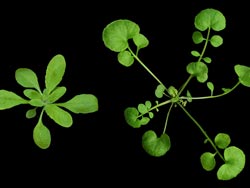Gene for dissected leaves

The thale cress has simple oval leaves, the hairy bittercress, in contrast, develops complex leaves with leavelets.<br><br>© MPI f. Plant Breeding Research/ Lempe<br>
Spinach looks nothing like parsley, and basil bears no resemblance to thyme. Each plant has a typical leaf shape that can differ even within the same family. The information about what shape leaves will be is stored in the DNA.
According to researchers at the Max Planck Institute for Plant Breeding Research in Cologne, the hairy bittercress (Cardamine hirsuta) has a particular gene to thank for its dissected leaves. This homeobox gene inhibits cell proliferation and growth between leaflets, allowing them to separate from each other. The thale cress Arabidopsis thaliana does not have this gene. Therefore, its leaves are not dissected, but simple and entire.
Miltos Tsiantis and his colleagues at the Max Planck Institute for Plant Breeding Research in Cologne discovered the new gene when comparing two plants from the Brassicaceae family: Cardamine hirsuta has dissected leaves that form leaflets and Arabidopsis thaliana has simple leaves. The researchers identified the RCO (REDUCED COMPLEXITY) gene, which makes leaves of the hairy bittercress more complex. Arabidopsis lacks this gene and, accordingly, lacks leaflets. RCO is only active in growing leaves. RCO ensures that cell proliferation and growth is prevented in areas of the leaf margin between sites of leaflet formation. “The leaves of Arabidopsis are simple and entire because growth is not inhibited by the RCO gene,” explains Tsiantis. “If we had not compared the two plants we would never have discovered this difference, as it is impossible to find a gene where none exists,” he adds.
The scientists first identified the RCO gene through a mutation in the hairy bittercress. In the absence of functional RCO the hairy bittercress can no longer produces leaflets. The RCO gene belongs to a cluster of three genes, which arose during evolution through the duplication of a single gene. In the thale cress, the original triple cluster now consists of a single gene. When the scientists return the RCO gene to the thale cress in the laboratory, evolution is partially reversed. “The simple oval leaves of Arabidopsis now develop deep lobes” says Tsiantis, “The fact that the leaf shape becomes complex again through the transfer of the RCO gene alone, shows that most of the apparatus for the formation of leaflets must still be present in the thale cress and was not lost with the RCO gene.”
The research team also examined the RCO sequence in greater detail and found it is a Homeobox gene. These genes function like genetic switches in that they activate or deactivate other genes. The scientists also demonstrated that RCO function is restricted to leaf shape; it does not decide whether leaves actually form. The loss of the RCO gene does not give rise to any other visible changes in the hairy bittercress. Therefore, its effect is limited to the inhibition of growth on the leaf margin. RCO does not work with the plant hormone auxin here. This specificity makes RCO a more likely driver of leaf shape evolution than any other genes identified to date. Tsiantis and his colleagues aim to decode its exact functionality in the months to come.
The scientists also examined the two genes which form a cluster with RCO and which arose in the course of evolution through the duplication of a precursor gene. They wanted to find out how the novel function of RCO in promoting leaf complexity arose. Apparently, the main functional difference lies in the control regions of the genes and not in the protein sequences. The control regions dictate when and how the relevant gene is read. If one or other of the two genes is subjected to the effect of the RCO control region, Arabidopsis makes complex leaves. Thus, the dissected leaves of the hairy bittercress are primarily owed to the control region of the RCO gene.
Contact
Prof. Dr. Miltos Tsiantis
Max Planck Institute for Plant Breeding Research, Köln
Phone: +49 221 5062-106
Fax: +49 221 5062-107
Email: tsiantis@mpipz.mpg.de
Original publication
Daniela Vlad et al.
Leaf Shape Evolution Through Duplication, Regulatory Diversification, and Loss of a Homeobox Gene.
Science, February 14, 2014 (DOI: 10.1126/science.1248384)
Media Contact
More Information:
http://www.mpg.de/7924634/gene_for_plant_leaves_with_leafletsAll latest news from the category: Life Sciences and Chemistry
Articles and reports from the Life Sciences and chemistry area deal with applied and basic research into modern biology, chemistry and human medicine.
Valuable information can be found on a range of life sciences fields including bacteriology, biochemistry, bionics, bioinformatics, biophysics, biotechnology, genetics, geobotany, human biology, marine biology, microbiology, molecular biology, cellular biology, zoology, bioinorganic chemistry, microchemistry and environmental chemistry.
Newest articles

High-energy-density aqueous battery based on halogen multi-electron transfer
Traditional non-aqueous lithium-ion batteries have a high energy density, but their safety is compromised due to the flammable organic electrolytes they utilize. Aqueous batteries use water as the solvent for…

First-ever combined heart pump and pig kidney transplant
…gives new hope to patient with terminal illness. Surgeons at NYU Langone Health performed the first-ever combined mechanical heart pump and gene-edited pig kidney transplant surgery in a 54-year-old woman…

Biophysics: Testing how well biomarkers work
LMU researchers have developed a method to determine how reliably target proteins can be labeled using super-resolution fluorescence microscopy. Modern microscopy techniques make it possible to examine the inner workings…





















